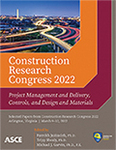Network Topologies and Team Performance: A Comparative Study of AEC Projects
Publication: Construction Research Congress 2022
ABSTRACT
The inherent characteristics of the Architectural, Engineering, and Construction (AEC) industry require experts from various organizations and disciplines to collaborate toward shared project goals. However, it is significantly difficult to connect individuals from diverse disciplines, backgrounds, organizations, and effectively integrate their knowledge. Social network approach addresses integration and know-how flow dynamics. However, there is a knowledge gap regarding how network topologies (i.e., parameters relating to nodes, ties, boundaries, and their placements across network) help improve knowledge transfers and optimize project outcomes. Thus, this study compares the network topologies of two similar AEC project teams. We collected e-mail exchange, observational, and archival data and conducted surveys from two projects during the construction phase and performed mixed methods of analysis. The study findings showed different network topologies between the two projects and one of the project networks evolved based on the project needs which yielded better performance. The results suggest that network parameters are not meaningful alone and engagement and network topology matter in measuring AEC project team performance. The results shed light on dynamic and multidimensional characteristics of knowledge transfer networks in complex project teams and contribute to the body of knowledge by providing a methodology in studying project teams in this light.
Get full access to this article
View all available purchase options and get full access to this chapter.
REFERENCES
Albert, R., and Barabási, A.-L. (2002). “Statistical mechanics of complex networks.” Reviews of Modern Physics, 74(1), 47–97.
Boccaletti, S., Latora, V., Moreno, Y., Chavez, M., and Hwang, D. U. (2006). “Complex networks: Structure and dynamics.” Physics Reports, 424(4), 175–308.
Castillo, T., Alarcón, L. F., and Salvatierra, J. L. (2018). “Effects of Last Planner System Practices on Social Networks and the Performance of Construction Projects.” Journal of Construction Engineering and Management, 144(3), 04017120.
Chinowsky, P., Diekmann, J., and Galotti, V. (2008). “Social network model of construction.” Journal of construction engineering and management, 134(10), 804–812.
Cross, R., Borgatti, S., and Parker, A. (2002). “Making invisible work visible: Using social network analysis to support strategic collaboration.” California Management Review, 44, 25–46.
Du, J., Zhao, D., Issa, R. R. A., and Singh, N. (2020). “BIM for improved project communication networks: Empirical evidence from email logs.” Journal of Computing in Civil Engineering, 34(5), 04020027.
Duva, M., Mollaoglu, S., Zhao, D., and Frank, K. (2020). “Expertise flows in AEC projects: An analysis of multi-level teams for sustainability.” Proc., 18th Annual Engineering Project Organization Conference (EPOC).
Frank, K. A., and Fahrbach, K. (1999). “Organization culture as a complex system: Balance and information in Models of Influence and Selection.” Organization Science, 10(3), 253–277.
Frank, K. A., Penuel, W. R., and Krause, A. (2015). “What is a “good” social network for policy implementation? The flow of know-how for organizational change.” Journal of Policy Analysis and Management, 34(2), 378–402.
Frank, K. A., and Zhao, Y. (2005). “Subgroups as meso-level entities in the social organization of schools.” Social Organization of Schooling, The, L. V. Hedges, and B. Schneider, eds., Russell Sage Foundation, 200–224.
Franz, B., Leicht, R., and Maslak, K. (2018). “Framework for assessing resilience in the communication networks of AEC teams.” The Engineering Project Organization Journal, 8.
Garcia, A. J., Duva, M., Mollaoglu, S., Zhao, D., Frank, K., and Benitez, J. (2020). “Expertise flows and network structures in AEC project teams.” Proc., Construction Research Congress (CRC), ASCE, Tempe, AZ.
Garcia, A. J., Mollaoglu, S., Frank, K. A., Duva, M., and Zhao, D. (2021). “Emergence and evolution of network structures in complex interorganizational project teams.” Journal of Management in Engineering, 37(5), 04021056.
Granovetter, M. S. (1973). “The strength of weak ties.” American Journal of Sociology, 78(6), 1360–1380.
Hanneman, R. A., and Riddle, M. (2005). Introduction to social network methods, (Electronic book), University of California, Riverside, CA.
Henry, A. D., and Vollan, B. (2014). “Networks and the challenge of sustainable development.” Annual Review of Environment and Resources, 39(1), 583–610.
Iorio, J., Taylor, J. E., and Sturts Dossick, C. (2012). “A bridge too far: Examining the impact of facilitators on information transfer in global virtual project networks.” Engineering Project Organization Journal, 2(4), 188–201.
Kereri, J. O., and Harper, C. M. (2019). “Social Networks and Construction Teams: Literature Review.” Journal of Construction Engineering and Management, 145(4), 03119001.
Korkmaz, S., and Singh, A. (2012). “Impact of team characteristics in learning sustainable built environment practices.” Journal of professional issues in engineering education and practice, 138(4), 289–295.
Lin, S.-C. (2015). “An Analysis for Construction Engineering Networks.” Journal of Construction Engineering and Management, 141(5), 04014096.
Marco, M. K. D., Taylor, J. E., and Alin, P. (2010). “Emergence and role of cultural boundary spanners in global engineering project networks.” Journal of Management in Engineering, 26(3), 123–132.
Mollaoglu-Korkmaz, S., Miller, V. D., and Sun, W. (2014). “Assessing key dimensions to effective innovation implementation in interorganizational project teams: An Integrated Project Delivery case.” Engineering Project Organization Journal, 4(1), 17–30.
Moreno, J. L. (1960). The sociometry reader, Free Press, New York, NY, US.
Poleacovschi, C., and Javernick-Will, A. (2017). “Who Are the Experts? Assessing Expertise in Construction and Engineering Organizations.” Journal of Construction Engineering and Management, 143(8), 04017033.
Schröpfer, V., Tah, J., and Kurul, E. (2017). “Mapping the knowledge flow in sustainable construction project teams using social network analysis.” Engineering, Construction and Architectural Management, 24, 229–259.
Valente, T. (2012). “Network interventions.” Science (New York, N.Y.), 337, 49–53.
Zhao, D., Duva, M., Mollaoglu, S., Frank, K., Garcia, A., and Tait, J. (2021). “Integrative collaboration in fragmented project organizations: Network perspective.” Journal of Construction Engineering and Management, 147(10), 04021115.
Zhao, D., Simmons, D., and Chen, Z. (2021). “Interconnectivity in collaboration networks impact on member belongingness.” Journal of Construction Engineering and Management, 147(8), 04021078.
Information & Authors
Information
Published In
History
Published online: Mar 7, 2022
Authors
Metrics & Citations
Metrics
Citations
Download citation
If you have the appropriate software installed, you can download article citation data to the citation manager of your choice. Simply select your manager software from the list below and click Download.
